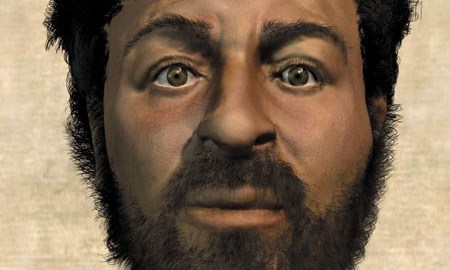Will The Real Jesus Please Step Forward?

Rights over the real Jesus have been contested since the day the man died. While the compiled gospels reveal different aspects of the carpenter’s life, in modern times nobody has been more successful at deciding what Jesus looked like than Warner Sallman. According to his publishers, his Head of Christ has been reproduced over 500 million times. Since 1940 his is the image, in the West at least, that has dominated.
Yet the faithful always want their deities to look and act like them. Head of Christ is the perfect American Jesus the way Joseph Smith is the perfect Christian-American prophet. Biblical lore, he claimed, would again go down, only this time on America’s soil. Sallman nailed the image, and ever since Jesus has been considered pretty much American.
Americans are not alone in this assumption. Jesus takes on the characteristics of whatever culture is depicting him. That has always been the case; it’s quite challenging to imagine it otherwise, given our innate love of ourselves and the community we chose to associate with. Sallman simply had a fanatic marketing machine behind him that propelled his painting to inconceivable borders.
Enter forensic anthropology. Medical artist Richard Neave, who has in the past reconstructed the faces of Alexander the Great and King Midas, took a stab at the famous prophet. His conclusion, pictured above, fits the bill of the Semites of the time when Jesus was alive, much to the consternation of those who grew up believing Sallman had the inside scoop.
I’m not convinced that churches worldwide will be replacing Sallman’s images anytime soon. Accepting evidence that contradicts previous claims is one of the more challenging aspects of being human. Perhaps nobody put this more to the test than social psychologist Milton Rokeach.
In 1959, Rokeach brought together three paranoid schizophrenics at Michigan’s Ypsilanti State Hospital. For roughly two years Clyde Benson, Joseph Cassel, and Leon Gabor (all fake names) worked together and lived alongside one another, meeting daily to discuss, among other things, their personalities. This unique experiment was especially eye-opening considering all three men thought they were Jesus Christ.
Joseph Campbell famously stated that Buddhists don’t dream of Jesus. Context and upbringing are everything in one’s religious life. If the main image you’re presented with is a serene, meditating Siddhartha, that will imprint in your mind. Such is the case with Jesus. The Ypsilanti patients were not all religious before schizophrenia set in. Growing up in Western cultures, Jesus’ image was inescapable. The sons of God all assumed that he must be them.
Regarding identity, Rokeach began with three assumptions:
He goes on to write that identity is a social as well as individual question. We don’t create our identities in a vacuum. We need the reflection of the outer world to understand who we are; that self is a fluid, dynamic character that changes with the situation. At root, we all have one self we believe to be a static, consistent being throughout our life, though that too is always in flux.
For the paranoid schizophrenics in Rokeach’s study, this was the case. When their identities were questioned in the presence of others claiming the same identity, they reacted in different ways. First there was resistance; the other two had to be lying, false gods. With more exposure one slowly yielded. The other two, while never giving up their delusions, called into question their identity in startling ways.
Rokeach later felt his experiment was morally questionable. He regretted doing it considering the incredible stresses placed on his three patients. But his research (and subsequent book) offers us lucid insight into the nature of identity: how we create our own; how we imagine the identities of others; how we act when our identity is brought into question.
No identity in recorded history has been claimed more than Jesus Christ. No figure has been misquoted to fit various agendas as often as this man. And, given that there is no DNA or anthropological evidence of his true existence to go by, this will be the case for some time. Neave’s insightful portrait does at least give us a more realistic glimpse than ever before. What was truly going on inside that head will most likely forever remain a mystery.
—
Derek Beres is a Los Angeles-based author, music producer, and yoga/fitness instructor. Follow him on Twitter @derekberes.





